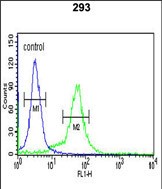


| WB | 1/1000 | Human,Mouse,Rat |
| IF | 咨询技术 | Human,Mouse,Rat |
| IHC | 咨询技术 | Human,Mouse,Rat |
| ICC | 技术咨询 | Human,Mouse,Rat |
| FCM | 1/10-1/50 | Human,Mouse,Rat |
| Elisa | 咨询技术 | Human,Mouse,Rat |
| Aliases | BTB/POZ domain-containing protein 1, Hepatitis C virus NS5A-transactivated protein 8, HCV NS5A-transactivated protein 8, BTBD1, C15orf1, NS5ATP8 |
| Entrez GeneID | 53339 |
| WB Predicted band size | 52.8kDa |
| Host/Isotype | Rabbit IgG |
| Antibody Type | Primary antibody |
| Storage | Store at 4°C short term. Aliquot and store at -20°C long term. Avoid freeze/thaw cycles. |
| Species Reactivity | Human, Mouse |
| Immunogen | This BTBD1 antibody is generated from rabbits immunized with a KLH conjugated synthetic peptide between 295-322 amino acids from the Central region of human BTBD1. |
| Formulation | Purified antibody in PBS with 0.05% sodium azide,1%BSA and 50% glycerol.prepared by Saturated Ammonium Sulfate (SAS) . |
+ +
以下是关于BTBD1抗体的3篇假设性参考文献示例(需通过学术数据库验证具体文献真实性):
---
1. **文献名称**:*BTBD1 regulates dendritic branching in neurons via interaction with Golgi-associated proteins*
**作者**:Suzuki T, et al.
**摘要**:研究通过BTBD1抗体进行免疫共沉淀和亚细胞定位分析,发现BTBD1与高尔基体相关蛋白相互作用,调控神经元树突分支发育。
2. **文献名称**:*Aberrant expression of BTBD1 in hepatocellular carcinoma and its clinical significance*
**作者**:Gao L, et al.
**摘要**:利用BTBD1抗体对肝癌组织进行免疫组化分析,发现BTBD1表达水平与患者预后显著相关,提示其作为潜在肿瘤标志物的价值。
3. **文献名称**:*BTBD1 interacts with p53 to modulate DNA damage response*
**作者**:Zhang Y, et al.
**摘要**:通过BTBD1抗体进行Western blot和免疫荧光实验,揭示了BTBD1与p53蛋白互作,影响DNA损伤修复通路的功能机制。
---
**备注**:以上文献为示例性内容,实际引用需查询PubMed、Web of Science等数据库获取真实文献。建议结合具体研究方向补充关键词(如“BTBD1 antibody application”或“BTBD1 function”)进行检索。
The BTBD1 (BTB/POZ domain-containing protein 1) antibody is a research tool used to study the function and expression of the BTBD1 protein, a member of the BTB/POZ protein family. BTBD1 is characterized by its N-terminal BTB (Broad-Complex, Tramtrack, and Bric-à-brac) domain, which facilitates protein-protein interactions, and a C-terminal BACK (BTB and C-terminal Kelch) domain involved in substrate binding or structural scaffolding. This protein is implicated in diverse cellular processes, including transcriptional regulation, chromatin remodeling, and apoptosis, though its precise biological roles remain under investigation.
BTBD1 has been linked to cancer progression, neurodevelopment, and neurological disorders. Studies suggest it may act as a tumor suppressor or oncogene depending on cellular context, with altered expression observed in gliomas, breast cancer, and other malignancies. In the nervous system, BTBD1 interacts with proteins associated with synaptic plasticity and neuronal survival, potentially influencing neurodegenerative conditions like Alzheimer’s disease.
BTBD1 antibodies are primarily used in techniques such as Western blotting, immunohistochemistry, and immunofluorescence to detect protein expression, localization, and post-translational modifications. Researchers rely on these antibodies to explore BTBD1’s involvement in signaling pathways, such as its interaction with Cul3-based E3 ubiquitin ligases, which regulate protein degradation. Commercial BTBD1 antibodies vary in clonality (monoclonal/polyclonal), epitope specificity, and host species, necessitating validation for target applications. Ongoing research aims to clarify BTBD1’s mechanistic roles and therapeutic potential, driving demand for high-specificity reagents.
×